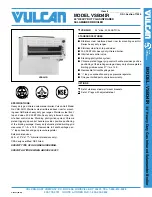
Installation & Operation Manual
69
12
Maintenance
(continued)
Figure 12-2
Burner Assembly
Check flame signal
1. At high fire the flame signal shown on the display should
be at least 10 microamps.
2. A lower flame signal may indicate a fouled or damaged
flame sense electrode. If cleaning the flame sense
electrode does not improve, ground wiring is in good
condition, and ground continuity is satisfactory, replace
the flame sense electrode.
3. See Section 3 - Troubleshooting of the Knight Wall Mount
Service Manual for other procedures to deal with low
flame signal.
Review with owner
1. Review the Knight Wall Mount User’s Information
Manual with the owner.
2. Emphasize the need to perform the maintenance schedule
specified in the Knight Wall Mount User’s Information
Manual (and in this manual as well).
3. Remind the owner of the need to call a licensed contractor
should the boiler or system exhibit any unusual behavior.
4. Remind the owner to follow the proper shutdown
procedure and to schedule an annual start-up at the
beginning of the next heating season.
Oiled bearing circulators
1. The circulator shipped with the Knight wall mount boiler is
water-lubricated. No oiling is required.
2. Check other circulators in the system. Oil any circulators
requiring oil, following circulator manufacturer’s
instructions. Over-oiling will damage the circulator.
3. Replace the boiler front access cover.
The boiler contains ceramic fiber materials.
Use care when handling these materials per
instructions in the Service Manual. Failure to
comply could result in severe personal
injury.
WARNING
Cleaning boiler heat exchanger
For recommended materials; including brush, appropriate
extension(s), refractory cover, and detailed instructions see
Table 12B - Heat Exchanger Cleaning Kits.
1.
Shut down boiler:
• Follow the “To Turn Off Gas to Appliance” instructions
for the boiler in Section 10 - Startup.
• Do not drain the boiler unless it will be exposed to
freezing temperatures. If using freeze prevention fluid
in system, do not drain.
2.
Allow time for the boiler to cool to room temperature if it
has been firing.
3.
Remove the nuts securing the heat exchanger access cover
to the heat exchanger and set aside.
5.
Remove the condensate hose from the heat exchanger end.
Connect a field supplied 3/4" diameter hose to a drain pan.
Using field supplied means, cover the refractory in the back
of the combustion chamber of the heat exchanger.
6. Use a vacuum cleaner to remove any accumulation on the
boiler heating surfaces. Do not use any solvent.
7. Brush the heat exchanger while dry using a nylon bristle
brush.
Caution:
DO NOT use a metal brush. Re-vacuum
the heat exchanger.
8. Finish cleaning using a clean cloth dampened with warm
water. Rinse out debris with a low pressure water supply.
9. Allow the heat exchanger to thoroughly dry.
10. Remove the field supplied rear refractory cover from the
back of the combustion chamber of the heat exchanger and
reassemble.
11. Close isolation valves on piping to isolate boiler from
system. Attach a hose to the boiler drain and flush boiler
thoroughly with clean water by using purging valves to
allow water to flow through the water make-up line to the
boiler.
12. Perform start-up and check-out procedures in the Check
Flame and Combustion - Section 10 - Startup on pages 51
and 53 of this manual.
13. Replace the access cover and restore boiler to operation.
Table 12B
Heat Exchanger Cleaning Kits
Model
Kit
Number
Part
Number
Component
Description
50 - 105
KIT30062
CTN20005
Rear Refractory Cover
MSC20083*
Nylon 4" Wheel Brush*
MSC20085
1/4" x 12" Drill Extension
150 - 210
KIT30063
CTN20005
Rear Refractory Cover
MSC20083*
Nylon 4" Wheel Brush*
MSC20084
3mm Allen Wrench
MSC20086
1/4" x 24" Drill Extension
* Do NOT use a metal brush. Only use the
kit provided brush or an equivalent
replacement nylon brush.
CAUTION
4.
Remove the heat exchanger access cover, burner, and
gas/air arm assembly.




































